|
|
Post by tomcatpc on Oct 24, 2016 18:46:50 GMT -8
So the 1961 and 1962 Scubair 300 are different, at least in outside appearance? My 300 has more in common with my Scuba Star than it does with my Scubair. In this photo, I see the "ethnic kinship" between the Scubair and Scubair 300 very clearly. This is why I'm stoked to see the thread started.
Mark
|
|
|
|
Post by tomcatpc on Oct 24, 2016 20:27:47 GMT -8
Really weird question about the Scubair 300, concerning the sound the sonic reserve makes.
Does the sound vary from the early to later versions?
Mine, which I think is the early version makes a sound that I can only describe sounding like a louder "ball point pen", but only having one click, but sounding a bit "heavier". It is only that one single heavy "click" sound when I inhale and the pressure is down to 300 PSI (or in my case with the J-Valve up, at 600 PSI, then goes away when I pull the rod).
If I recall you (Jay) said your Scuba 300 sounded sort of like a kazoo, with more of a "buzzing" sound? If I recall, the video that Scuba 2000 did on the ScubaPro sonic reg., sounded very similar to what you described.
When I took my 300 apart and cleaned it up and put it back together, I did not see anything broken, nor do I think I messed anything up somehow. Hope that somehow all made sense?
Mark
|
|
|
|
Post by nikeajax on Oct 24, 2016 22:47:45 GMT -8
Mark, they are different, but I really have no idea how your early model differs from the newer one: I wish you'd have taken some pictures so we could compare the technology. If you go back and read the description from "Basic Scuba" I posted, he was saying that the 1961 models were a bit disappointing, not as audible. Yeah, mine is a lot like a kazoo, but perhaps with some hair pins and a few ball bearings rattling around in there too: it really an odd sound that does get your attention. I've heard that the SP Mk-VII is a real teeth rattler...
JB
|
|
|
|
Post by tomcatpc on Oct 25, 2016 10:42:54 GMT -8
Yep, reading that makes sense. Looks like mine is working fine and they are different in the sound. Bottom line is that it does get my attention when it is running low.
Mark
|
|
|
|
Post by nikeajax on Oct 25, 2016 14:29:20 GMT -8
On the 1962 model Scubair, there are mysterious markings on the side knob that prove to be quite enigmatic to all but the most knowledgeable of divers. Here at the " VSF" we are privileged to have John Ratliff as someone who is one of keepers, and sharers, of the esoteric and obtuse know-how it takes to use regulators like this: this is because he used them when they were new technology. 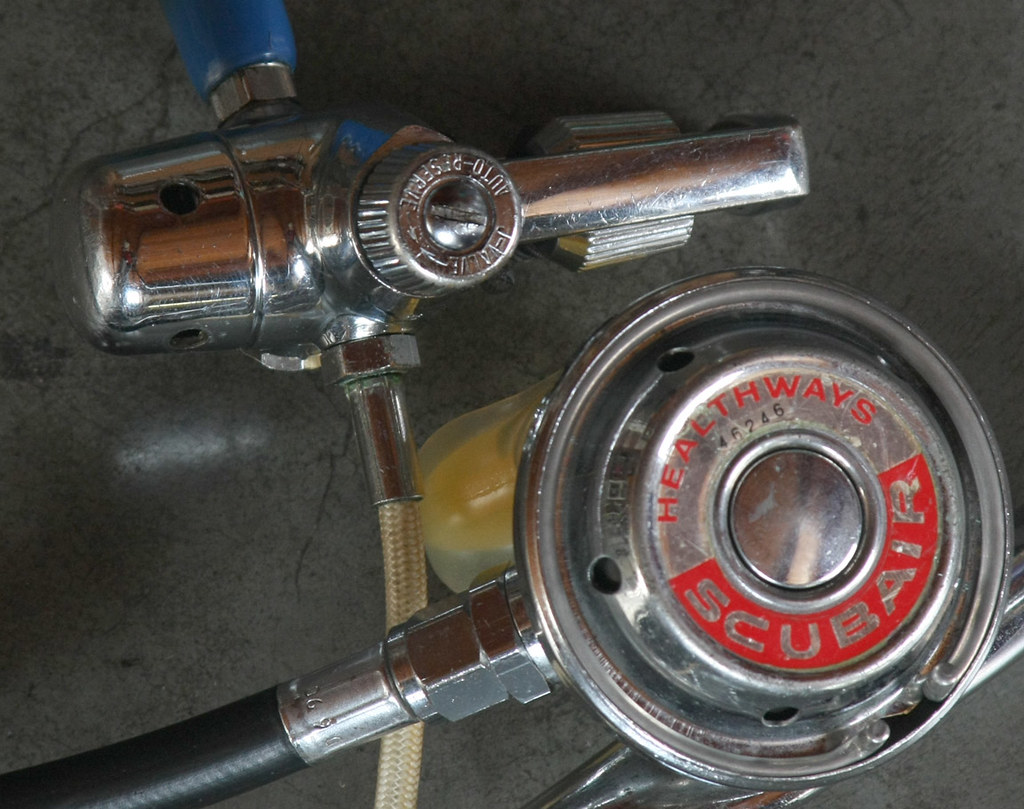 I am going to paraphrase John here with his explanation as to how this feature works:
In the early 1960s you could buy a scuba tank with either a J-valve or a K-valve: with the J-valve, you had a reserve, but, on the other hand, if you had a K-valve, there was no warning that you were running out of air. So Healthways made the Scubair regulator with what is known as a restrictor orifice. With the “J-valve” setting, to be used with a tank with a j-valve, the air going through the regulator bypasses the restrictor orifice: with the "Auto Reserve" setting, the air was forced through the restrictor section, actually a second calibrated opening on the regulator, then to the second stage. At about 500 psig, the diver could feel a slight hesitation in the air flow, as the air had to pass through this small tube. This would signal the diver that it was time to surface. The restriction in air flow, and increase in breathing effort, got higher as the tank pressure fell. This happened "automatically," and the diver did not have to do anything to feel this restriction. Remember, this was before SPGs were generally available. The restriction became less as the diver surfaced, so it was said to "force" the diver to surface. To get better breathing out of the regulator, the diver needed to ascend. This presented a difficulty to divers who may need to descent in order to get out from under something (cave, ship wreck, etc.). For the Scubair, the diver would have difficulty changing the setting underwater. As with pressure on the regulator, this knob was hard to turn and difficult to reach.
The Sucba Star regulator had a similar restrictor orifice that could be ordered if the diver was using a K-valve-equipped tank, but it was behind the sintered filter and not easily changeable. 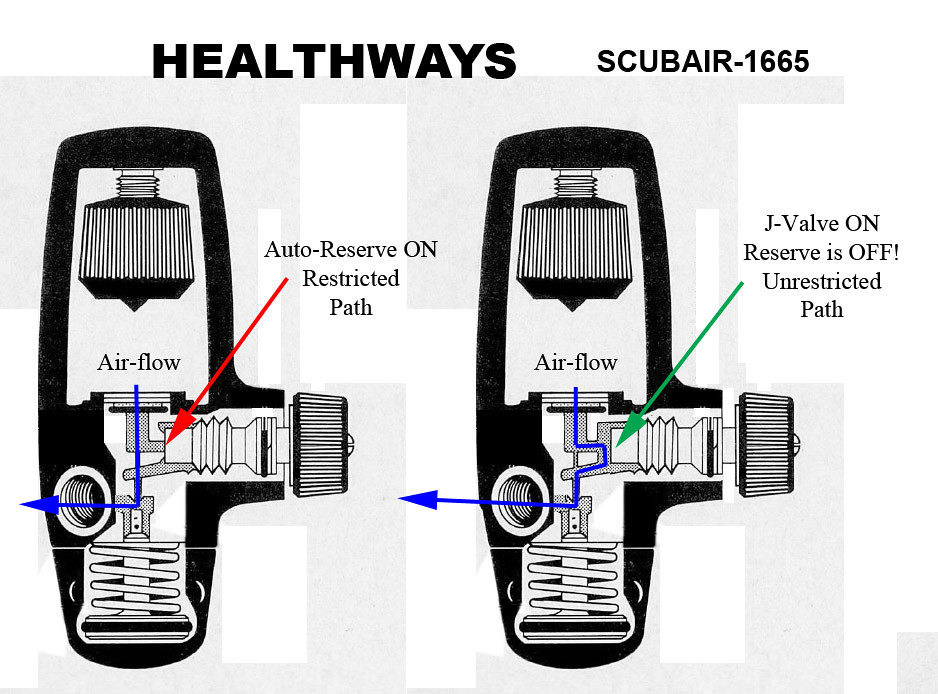 |
|
|
|
Post by tomcatpc on Oct 25, 2016 15:06:11 GMT -8
"Here at the "VSF"" Ha ha!!!
I, with three whole years of diving under my weight belt, knew what the Auto-Reseve/J-Valve is. Yes, we are good to have John here...
Be like me and use the Auto-Reserve setting with a J-Valve on the tank...make it to the surface with about 400 PSI remaining and keep the modern diving gurus semi-satified. Ha!
Mark
|
|
|
|
Post by tomcatpc on Oct 25, 2016 19:34:48 GMT -8
Jaybird...later this Winter I'll take the 300 apart again and try to get a decent photo. It is not a big deal to take apart. Now the Scubair, that I had a "fun" time getting the selector knob part to seal decently.
Mark
|
|
|
|
Post by nikeajax on Nov 3, 2016 13:40:57 GMT -8
For 1963, Healthways introduced the Scubair-J model-1662. This was essentially the second generation Scubair model-1665 (not to be confused with the first generation Scubair model-1665) but they had simply attached a j-valve to the body and didn't drill out the vein for the auto-reserve feature, see second image for comparison of the two. 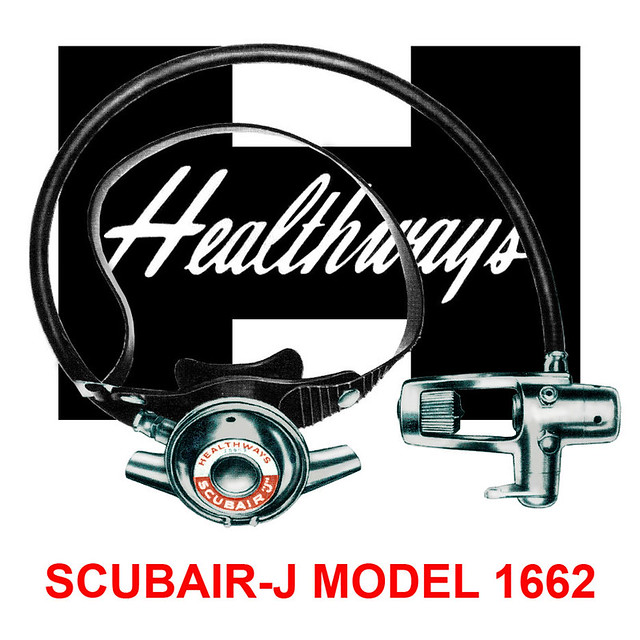 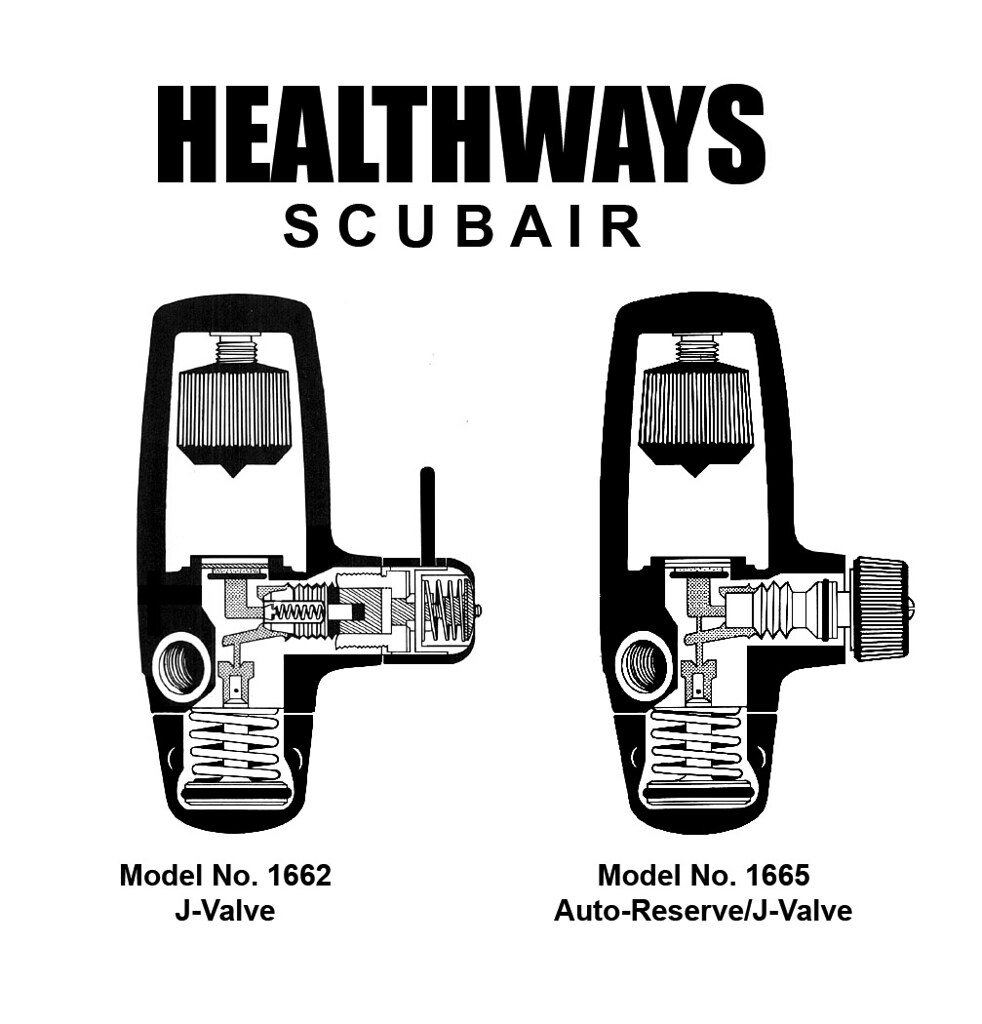 Jaybird |
|
|
|
Post by SeaRat on Nov 3, 2016 14:34:20 GMT -8
Hi Jaybird,
I did not realize that the internals were so similar between the Scubair and the Scubair-J. That's pretty nice engineering! I have both of these regulators too.
John
|
|
|
|
Post by nikeajax on Nov 7, 2016 10:14:46 GMT -8
Here's an image of a mythical regulator: the Scubair + B, model-1666. This would later evolve into the Scubair-"B". "B" was their designation for a balanced regulator. It was promised in their 1965 catalog, very much as their double hose "Scuba Master" that never came to be either. I have recreated it here. It would have the same selection knob as the earlier model-1665 but was balanced, and like the ScubaPro Mk.V, the yoke was moved to the side of the regulator. 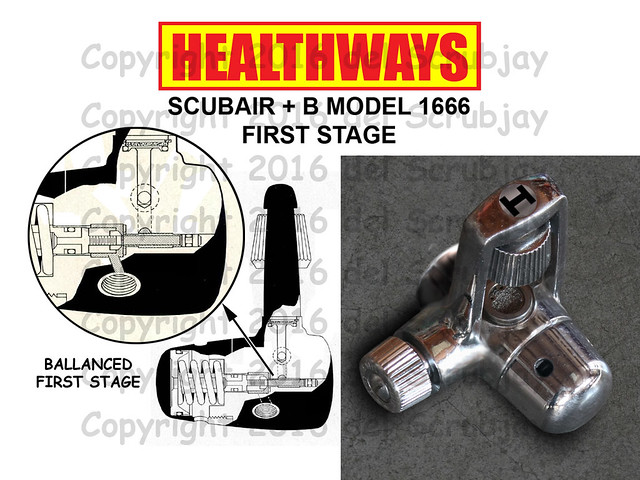 JB |
|
|
|
Post by SeaRat on Nov 7, 2016 14:46:03 GMT -8
Now I know why I had never seen it before; it is a mythical regulator, promised, but never produced (apparently). Wow, that is a great set of drawings and image. Thanks, Jaybird.
John
|
|
|
|
Post by nikeajax on Nov 7, 2016 17:09:14 GMT -8
John, when I first discovered the 1666 in the catalog, my first thought was (expletive deleted), yet another HW reg that I need for my collection... Then looking at subsequent years, it never materialized!
JB
|
|
|
|
Post by tomcatpc on Nov 7, 2016 20:14:13 GMT -8
1666, that was the year London burned, following the return of the Plague the previous year...
What that has to do with Healthways Single Hose Regulators of yore...,I know not. Other than I enjoy diving with Healthways Regs., and I had relatives that survived the Plague (both 1349 and 1665) and the Great Fire of London...
OK...that was weird...
Mark
I'm completely sober, just trying to be funny...
|
|
retpo
Senior Diver
 
Posts: 63 
|
Post by retpo on Nov 8, 2016 15:30:16 GMT -8
I have a Scuba Star TDQK, Anybody know what that stands for? Was the regulator actually made by Nemrod or someone else?
It has a lot of similarities to a Nemrod Snark II Deluxe.
|
|
|
|
Post by nikeajax on Nov 8, 2016 16:08:38 GMT -8
Hi Retpo! TDQK stands for "Total Demand Quick Klip".
I have seen images of the Snark-II, and you're right, they do look very similar! I know that Sherwood did the actual manufacturing of these regulators, for a lot of companies in reality, and they owned the patent for piston regulators.
The Snark-II was a direct copy of the Scuba Star: it may have been made in the same place? The Scuba Star was such a workhorse, like a Soviet AK-47asault rifle, cheap, easy to produce and simple to work on, that US Divers made their own version called, are you ready? Deep Star... The Deep Star first stage is nearly identical to the Scuba Star, but the USD DS has a larger piston, which was shared with the second generation Calypso!
JB
EDIT: This question is getting rather ahead of he game, but: the "QK", or Quick Klip designation was because, for a short time, HW was using the the ScubaPro style two-piece-bands to secure the top and bottom of their cans. They were also using modified SP cans. In 1971 or '72 they went back to the much simpler Quick Klips, and went back to their original can styling.
|
|